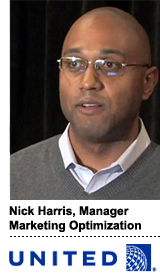 United Airlines services more than 5,000 flights a day to 400 different destinations around the world.
United Airlines services more than 5,000 flights a day to 400 different destinations around the world.
It uses desktop, mobile app, in-flight Wi-Fi, email and mobile web data to create an “intelligent, congruent customer experience,” said Nick Harris, senior manager of marketing channel optimization for United Airlines, at Ensighten’s Agility conference last week.
However, connecting the brand’s first-party data to third-party systems is a challenge, especially when factoring in offsite signals with the customer journey on United’s owned-and-operated properties, as many customers book via third-party travel search engines.
“A big blind spot today for Google Analytics and [Adobe] SiteCatalyst is there’s virtually no insight for impressions on view-throughs, only clicks,” said Harris. “Using standard analytics, you’re blind to [seeing] what people are scrolling through and taking action on.”
Harris claimed many vendors are restricting data from leaving their respective repositories, which can fracture horizontal attribution for marketers who need to stitch it all together.
“There is no one cross-channel identifier that goes across Google and Facebook, and we’re seeing a lot of companies investing in building comprehensive marketing technology stacks who are doing a good job of siloing your data,” Harris added.
Although some marketers prefer suites rather than point solutions, Harris thinks consolidating on one stack makes marketers less agile and makes it costly to change vendors.
Marketers have to replicate their campaigns in one environment, and Harris wishes vendors would enable seamless movement between platforms.
Thus, United is building its own first-party repository with Ensighten’s data activation platform Activate, which integrates with all data management platforms as well as site-level tag, analytics and first-party CRM data. However, Harris said there are still connectivity challenges, despite its desire for independent data ownership.
“We have an attribution implementation reliant on DoubleClick infrastructure, and we’ve experienced some data loss where things weren’t being translated correctly from Google servers back to United.com,” Harris said. “We needed to develop a custom map identifying patterns through campaign IDs, to enable linking back to the DoubleClick data set.”
Another challenge is connecting mobile to desktop experiences, a limitation United seeks to solve by the third quarter through a fully re-architected site experience.
“A lot of people start their search with our mobile app to determine prices, but want to log in on the desktop to see the full spectrum of services,” Harris said. “We don’t presently provide that back-end logic where, if a customer searches on mobile app, we’ll have recent searches and offers that will automatically populate the next time a customer comes to United.com. We’re solving that now.”
United’s base of authenticated users is fairly good. Eighty to 90% of customers using the mobile app are logged in vs. 10%-20% via mobile web, and 40%-50% of on-site traffic comes from logged-in users.
United anticipates that these authenticated users will help it stitch together customer behavior cross-device, in addition to cookie-level IDs amassed through Ensighten’s Pulse and other sources of data, such as loyalty mileage members.
“If you come to manage an existing itinerary, you have to authenticate, and if you do those cross-device, we can begin to piece together those identities,” Harris said.












